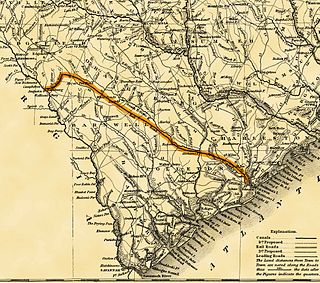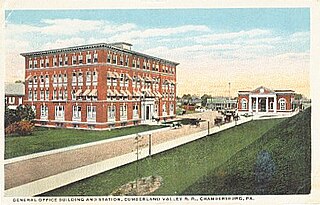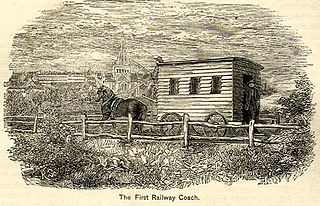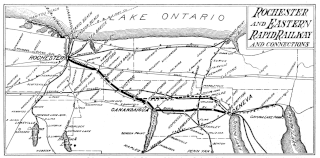 | |
| Overview | |
|---|---|
| Locale | New York, United States |
| Dates of operation | 13 May 1836–1 August 1850 |
| Successor | Rochester and Syracuse Railroad |
The Auburn and Rochester Railroad was a railroad company based in New York state in the 19th century.
 | |
| Overview | |
|---|---|
| Locale | New York, United States |
| Dates of operation | 13 May 1836–1 August 1850 |
| Successor | Rochester and Syracuse Railroad |
The Auburn and Rochester Railroad was a railroad company based in New York state in the 19th century.
The Auburn and Rochester Railroad Company was built to bring Canandaigua access to regional and national markets and sources. Extending southeast from Rochester to Geneva and Canandaigua with a trackage length of 78½ miles, its right-of-way exceeded that of the contemporaneous and nearby Auburn and Syracuse Railroad Company.
The road was chartered on 13 May 1836.
The Panic of 1837 slowed construction, and the Genesee River had to be bridged. The line reached Geneva in September 1840, Canandaigua in November 1841. Initially, some ninety percent of the line's business was the haulage of passengers, and local merchants had to persuade the company, in 1841, to schedule one freight run a week. [1]
If this railroad company started life unusually, it was in having its state charter specifically lay out its route. Normally, the charter granted by the legislature stipulates the termini, leaving the precise routing to the company, its directors, management, and engineers. When the New York Legislature established the Auburn and Rochester Railroad Company under Chapter 349 of the corporate law, "...the act provided that it should be constructed between the village of Auburn and the city of Rochester, 'commencing in the village of Auburn at the termination of the Auburn and Syracuse Railroad and running thence through the village of Seneca Falls and the town of Waterloo; the village of Geneva and the village of Vienna and the town of Manchester; the village of Canandaigua and thence through the town of Victor by the most eligible route to the city of Rochester where it may terminate at and connect with the Tonawanda Railroad.'" [2]
Henry Bicker Gibson, [3] a wealthy Canandaigua banker, provided the impetus and the direction, serving as a founder, an investor, and the president of the corporation. When the thirteen directors were elected in March, 1837, there were five hundred and forty-one subscribers to the company's stock. They represented not only Canandaigua, the center of interest in this railroad, but the intervening communities as well, reflecting the deep commercial interest that they had in a railroad connection to the rest of the country. Pivotal in making this undertaking happen was the state legislature's guarantee of the bonds with which it was financed. [4]
At the time, canals occupied a position of privilege in New York, with legal protection of their access to markets, sometimes bordering upon monopoly. The company's charter addressed the canal problem by granting the right to haul property as well as passengers, with this proviso "but the corporation hereby created shall not take and transport merchandise in such a manner as to lessen the income on the Erie Canal during the time when the canal is navigable."[ citation needed ] The charter did not specify either a penalty for contravention of this clause nor any means of its enforcement against the company. As far as is known, this was never tested in court; the matter became moot when the canal laws changed in 1844.
Gibson, an official of the Ontario Bank, was elected president, and Charles Seymour, the secretary and treasurer. They held these positions during the remaining corporate life of the company. When the Auburn and Rochester Railroad Company was consolidated on 1 August 1850 into the Rochester and Syracuse, they served in the same positions in that company and held them until that line was in turn merged into the New York Central.
The company appointed Robert Higham as engineer. He had been a resident engineer on the Utica and Schenectady; he left when the road was opened in August 1836, with a glowing commendation by his former employer. He built the Auburn and Rochester, serving for some years as its superintendent and went from this road to the Hudson River Railroad.
Higham set out to develop the route. The route surveys took the spring and summer of 1837. From his report to the board, one can derive a sense of the state of railroad technology at the time:
To the President and Directors of the Auburn and Rochester Railroad Company:
Gentlemen:
We shall be able to pass the whole distance, between Auburn and Rochester, without having any grade to exceed twenty-eight feet ascent or descent, per mile, and that without any very deep cuttings on the summits, or high embankments in the valleys. The curves generally will be of a large radius only one being as low as 1000 feet.
The work throughout, will be of a plain and easy character, without any heavy rock excavation, or expensive river walling, and with as little perishable structure as perhaps any Road of the same extent in the United States. The superstructure of bridges over the Erie and Seneca canals, the Seneca and Genesee rivers, and some others of minor importance, (the cost of the whole amounting to $19,190) in fact, constituting the only perishable part of the road; and allowing that this will require an expenditure equal to ten per cent per annum, on its cost, to renew and keep it in repair, will amount to $1,919 -- a mere nominal sum for repairs, on so great a work. This permanency in the character of the work, will unquestionably be a consideration of great importance, with those who wish to have their money invested in stocks that will yield them an annual return of profits instead of having it consumed in continual repairs.
The grading for that portion of the route which lies between the village of Auburn and Seneca Falls, is through gravel and clay soils; for the remainder of the distance it is generally through loam, sand and gravel, and at three several points some slight lime-rock cuttings, but not more than will furnish the necessary quantity of stone to be used for culverts and bridge abutments, in their vicinity.
The character of the masonry, I have estimated to be of plain, rough, hammer dressed stone work, laid in quick lime mortar.
The following estimates are made for grading and masonry for a double track -- the first track to be laid immediately, the second track as soon after as requisite. Considering this as one of the links in the great chain of Western Railroads, from Boston to Buffalo and the "far West," the estimates are made on a scale of corresponding character and magnitude to accommodate the business of this great and increasing thoroughfare; and nothing short of a double track will, in my opinion, be adequate for any great period. This is indicated by the fact, that the travel on the Utica and Schenectady Railroad, (which forms another link in this same chain) already requires the second track, to do the business of carrying passengers only; and the fact, that the Tonawanda Railroad, (from Rochester to Batavia) with its present accommodations, having only a single track, is inadequate to the business, although trains of cars run day and night.
The subject of wooden superstructure, from its importance, has occupied much attention. From the experience of the present day, there can be no question, that a combination of timber and iron makes, under all circumstances, the preferable road for this climate. The greatest objection to roads of this character, is the large amount of perishable materials used in their construction, as all the different kinds of timber that can be procured in sufficient size and quantities for rails, are not of a durable nature; and from their exposed situation near the surface of the ground they must decay very rapidly. It is found, that in ordinary cases, the common timber of the country will require replacing, on an average, every six or seven years.
The following plan for a durable structure, is suggested for your consideration, as a better and cheaper road, than the common modes: The sills to be 4 by 12 inches, well bedded; the top surface four inches below the grade of the road; on the sills are spiked cross-ties of red cedar, three inches thick, of any width not less than 4 inches, and two feet from centre to centre. Between the cross-ties are red cedar blocks, 3 by 6 inches, and one foot long, leaving spaces between the ties and blocks, not exceeding 8 inches. Upon the blocks and ties, and under the rail plates, is a locust ribbon, one inch thick and three inches wide, to raise the iron rail, and clear the flanges of the wheels from the ties. Upon the locust ribbon is placed the rail plate, one inch thick, 21⁄4 inches wide on the bottom, and two inches wide on the top. The spikes to pass through the iron plate, the locust ribbon and the ties, into the sills, confining the whole together.
The locust and cedar being durable beyond any experience, may be considered, practically, as permanent as the iron. The sills may be of any timber of the country; being bedded in the earth, and remaining moist and free from the action of the atmosphere they will last for a great length of time. The bearing between the ties and blocks being so small, the plate and ribbon will be abundantly strong for any weight that can at any time be brought upon them. Their spikes being one foot from centre to centre, and passing into the ties and sills, would have an equal or greater hold to keep the rail in its place, than in the common wooden rails. It is believed that the increased size of the rail plate will be materially important in giving stability to the road, and will be more than sufficient to compensate for the large wooden rails, in keeping the road firm and in place. [2]
The fare rates set by the charter provide some insight into prices of the day. The passenger fare per mile for one person and ordinary baggage was restricted to three cents. The company lobbied the legislature of 1837 to secure an increase to a maximum of four cents. Among the incentives for this move was the difficulty of attracting sufficient capital with the three cent limitation, other railroads having been granted better terms.
By 1848, the company had spent more than $2,655,000 on construction. The engineering estimate had been less than $1,450,000. However, the revenue realized by the railroad considerably exceeded the engineer's estimates.
Although the line had been planned to have double tracks, only one was ever built. As done on other early roads, strap rail construction was utilized. While this secured significant capital economies, it inevitably incurred greater operational risks, including the notorious "snakehead", in which the metal strap upon which the rolling stock rode would come loose from its wood support and be projected up through the car floor by the first wheel to snag the strap's end. There was, prior to 1848, no legal obligation to report accidents; company records show only a single snakehead incident, occurring in June 1848.
The line was opened in sections: from Rochester to Canandaigua on 19 September 1840; to Seneca Falls on 9 June 1841; to Cayuga on 18 September 1841; and to the terminus in Auburn on 4 November 1841. The average train speed was 14 miles an hour; this was attributed to the use of strap rails.
The wages paid were fixed by the Board of Directors. Typical values, in 1842, were:
Engineer and superintendent $3,000.00 (per annum) Receiver of tickets (at Rochester) 50.00 (per month) Receiver of tickets (at Auburn) 25.00 (per month) Conductor 50.00 (per month) general clerk 50.00 (per month) Freight agent 40.00 (per month) Baggage handler 25.00 (per month) Locomotive engineer 2.00 (per day)
One decision by the railroads in Rochester left passengers cold. The Tonawanda's ticket office was located in the United States Hotel on Main Street West, at the Erie Canal. The Auburn and Rochester built its terminal several blocks away. Because of pressure from local hotels, the only connection between the two railroads was a hack [note 1] trip, not an entirely pleasant experience for weary travelers, particularly in winter. Not until the state legislature intervened was this resolved; the Tonawanda blinked first and extended its line to the Auburn terminal, abandoning its old station on Buffalo Street. [note 2] The Auburn and Rochester station was on Mill Street, near State Street. The track into the station ran on what is today Central Avenue, having crossed East Avenue where today the Can of Worms stands.
The trip from Auburn to Rochester was seventy-six miles. If the train was on time, that took three hours and forty minutes.
On 1 August 1850, the Auburn and Rochester Railroad merged with the Auburn and Syracuse Railroad to form the Rochester and Syracuse Railroad. In turn, this merged with the Direct Railway between Syracuse and Rochester [note 3] five days later and was consolidated into the New York Central Railroad in 1853. The route is operated today by Finger Lakes Railway from Auburn to Victor with the section from Victor to Rochester abandoned with parts converted to a trail. In 1992, a Cobblestone Railroad Pumphouse constructed about 1845 and located at the hamlet of Fishers in Ontario County, New York was listed on the National Register of Historic Places. [5]

The Erie Canal is a historic canal in upstate New York that runs east–west between the Hudson River and Lake Erie. Completed in 1825, the canal was the first navigable waterway connecting the Atlantic Ocean to the Great Lakes, vastly reducing the costs of transporting people and goods across the Appalachians. In effect, the canal accelerated the settlement of the Great Lakes region, the westward expansion of the United States, and the economic ascendancy of New York State. It has been called "The Nation's First Superhighway."

The New York Central Railroad was a railroad primarily operating in the Great Lakes and Mid-Atlantic regions of the United States. The railroad primarily connected greater New York and Boston in the east with Chicago and St. Louis in the Midwest, along with the intermediate cities of Albany, Buffalo, Cleveland, Cincinnati, Detroit, Rochester and Syracuse. New York Central was headquartered in New York City's New York Central Building, adjacent to its largest station, Grand Central Terminal.

New York State Route 5 (NY 5) is a state highway that extends for 370.80 miles (596.74 km) across the state of New York in the United States. It begins at the Pennsylvania state line in the Chautauqua County town of Ripley and passes through Buffalo, Syracuse, Utica, Schenectady, and several other smaller cities and communities on its way to downtown Albany in Albany County, where it terminates at U.S. Route 9 (US 9), here routed along the service roads for Interstate 787 (I-787). Prior to the construction of the New York State Thruway, it was one of two main east–west highways traversing upstate New York, the other being US 20. West of New York, the road continues as Pennsylvania Route 5 (PA 5) to Erie.

Western New York (WNY) is the westernmost region of the U.S. state of New York. The eastern boundary of the region is not consistently defined by state agencies or those who call themselves "Western New Yorkers". Almost all sources agree WNY includes the cities of Buffalo, Niagara Falls, Jamestown, and the surrounding suburbs, as well as the outlying rural areas of the Great Lakes lowlands and Niagara Frontier, and Chautauqua-Alleghany. Many would also place Rochester and the Genesee Valley in the region while some would also include the western Finger Lakes within the region. Others would describe the latter three areas as being in a separate Finger Lakes region.

This is a list of the earliest railroads in North America, including various railroad-like precursors to the general modern form of a company or government agency operating locomotive-drawn trains on metal tracks.
The Auburn and Syracuse Railroad was incorporated on May 1, 1834, to provide easy access between Auburn, New York, and the Erie Canal. Construction was begun in 1835, but was delayed during the Panic of 1837. Although the economic downturn lingered until 1843, the railroad was completed by January 1838.
The Buffalo and Niagara Falls Railroad was a part of the New York Central Railroad system, connecting Buffalo, New York to Niagara Falls. It is still used by CSX for freight and Amtrak for passenger service.

The Finger Lakes Railway is a Class III railroad in the Finger Lakes region of New York. The company began operations on July 23, 1995, and operates in Onondaga, Cayuga, Seneca, Ontario, Schuyler and Yates counties. The FGLK operates 18 diesel locomotives on 167 miles (269 km) of ex-Conrail trackage, formerly owned by the New York Central Railroad, the Pennsylvania Railroad and the Lehigh Valley Railroad. Between 2001 and 2013, the railroad operated a heritage railroad known as the Finger Lakes Scenic Railway which offered passenger train excursions.

The South Carolina Canal and Rail Road Company was a railroad in South Carolina that operated independently from 1830 to 1844. One of the first railroads in North America to be chartered and constructed, it provided the first steam-powered, scheduled passenger train service in the United States.
The Elmira and Lake Ontario Railroad was a subsidiary of the Northern Central Railway and later the Pennsylvania Railroad, formed to give the Northern Central an outlet for coal traffic on Lake Ontario.

A predecessor to the Class I Delaware and Hudson Railway, the 1820s-built Delaware and Hudson Canal Company Gravity Railroad('D&H Gravity Railroad') was a historic gravity railroad incorporated and chartered in 1826 with land grant rights in the US state of Pennsylvania as a humble subsidiary of the Delaware and Hudson Canal and it proved to contain the first trackage of the later organized Delaware and Hudson Railroad. It began as the second long U.S. gravity railroad built initially to haul coal to canal boats, was the second railway chartered in the United States after the Mohawk and Hudson Rail Road before even, the Baltimore and Ohio. As a long gravity railway, only the Summit Hill and Mauch Chunk Railroad pre-dated its beginning of operations.
The Tonawanda Railroad was a railroad company established in Rochester, New York in 1832. It was eventually absorbed by the New York Central.
The Rochester Subdivision is a railroad line owned by CSX Transportation in the U.S. state of New York. The line runs from Solvay, New York, west to Churchville, New York, along the former New York Central Railroad water level route. At its east end, west of downtown Syracuse, New York, the line continues west from the Syracuse Terminal Subdivision at Control Point (CP)-296. It intersects the West Shore Subdivision, which provides a southern bypass of Rochester, at Fairport (CP-359) and Churchville (CP-382). At its west end in Churchville the line becomes the Buffalo Terminal Subdivision.

The Cumberland Valley Railroad was an early railroad in Pennsylvania, United States, originally chartered in 1831 to connect with Pennsylvania's Main Line of Public Works. Freight and passenger service in the Cumberland Valley in south central Pennsylvania from near Harrisburg to Chambersburg began in 1837, with service later extended to Hagerstown, Maryland, and then extending into the Shenandoah Valley to Winchester, Virginia. It employed up to 1,800 workers.

The Scottsville and LeRoy Railroad was a horse-drawn short-line railroad running from Scottsville to Caledonia, in New York State, in the United States of America. It was chartered in 1836 and ran until 1840, when changes in the canal system reduced demand. The eight-mile long line used wooden rails, which were a continual source of derailments.
The Railroad industry in Syracuse, New York got its start in October 1831 when a convention held in the city marked one of the earliest moves to stimulate the era of railroad building which ultimately brought steam railroad service to New York State.
The Rochester and Syracuse Railroad was a double-track, high-speed line 87 miles (140 km) long that ran between Rochester and Syracuse, New York. The tracks paralleled the New York Central Railroad and the Erie Canal and had only one grade crossing with another railroad its entire length.
The Auburn Trail is a multi-use rail trail located principally in the towns of Victor and Farmington, Ontario County, New York (USA). It is approximately 11 miles (18 km) long and maintained by the Towns of Victor and Farmington and Victor Hiking Trails. The trail mostly follows the alignment of the Auburn and Rochester Railroad. Additional disconnected portions of the Auburn trail are found in the Towns of Pittsford and Brighton, Monroe County, NY. A detailed description and map of the Auburn Trail are available from Victor Hiking Trails.

The Rochester and Eastern Rapid Railway (R&ER) was an electric interurban railway in New York State, USA, connecting Rochester, Canandaigua, and Geneva.
The Seneca Road Company was formed to improve the main road running west from Utica, New York, the Genesee Road, from Utica to Canandaigua and operate it as a toll road or turnpike. The road was originally laid out in 1794 from Baggs Square in downtown Utica at the ford of the Mohawk River and followed the Indian trail past Syracuse to Canandaigua. Some accounts say it went to Geneva and Avon originally. There was no City of Syracuse then. The road became known as the Seneca Turnpike, which was 157 miles (253 km) long and, at the time, the longest toll road in the state.